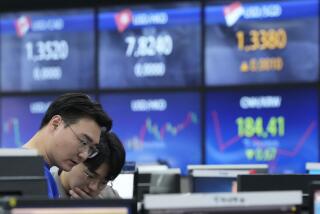Stocks Rally at End of Session; Dow Gains 16
- Share via
NEW YORK — Stock prices posted some spotty gains Thursday, rallying just before the close of a quiet session.
Retailing stocks were mostly higher as major companies in the industry reported a pickup in sales last month.
The Dow Jones average of 30 industrials, down 3 points heading into the last hour, closed with a 16.15-point gain at 1,879.44.
Volume on the New York Stock Exchange came to 110.92 million shares, against 116.96 million Wednesday.
Interest rates have been on the rise lately as evidence has accumulated that economic growth might be speeding up. The stock market’s response so far has been ambivalent, with traders alternatively showing concern about the interest rate rise and some optimism about prospects for corporate earnings.
Albert Wojnilower, economist at First Boston Corp., said he still believed that another round of discount rate reductions was likely at some point among the leading industrialized countries.
Investors in both stocks and bonds are expected to take their next cue from the government’s report today on the employment situation for May.
In the retail sector, F. W. Woolworth rose 2 5/8 to 47 1/2, Federated Department Stores 1 3/8 to 83 1/8, J. C. Penney 3/4 to 79, Zayre 1 1/2 to 81 1/2, K mart 5/8 to 53 and Sears, Roebuck 5/8 to 48.
Among actively traded blue-chip industrials, American Telephone & Telegraph added 1/2 to 25, International Business Machines gained 3/4 to 150 3/4 and American Express edged up 1/8 to 61 7/8.
Philadelphia Electric led the active list, up 1 1/2 at 18 3/4. Buying in the stock was attributed to indications that state regulators would grant larger-than-expected rate increases to cover the company’s Limerick Unit One nuclear power plant.
Bear, Stearns rose to 35. The company reported sharply higher quarterly earnings and declared a 3-for-2 stock split.
Beverly Enterprises was actively traded, up 5/8 at 40 1/2. The stock was added to Standard & Poor’s 500-stock composite index, prompting managers of so-called index funds that are designed to duplicate the performance of the 500 to buy the stock for their portfolios.
More to Read
Inside the business of entertainment
The Wide Shot brings you news, analysis and insights on everything from streaming wars to production — and what it all means for the future.
You may occasionally receive promotional content from the Los Angeles Times.










